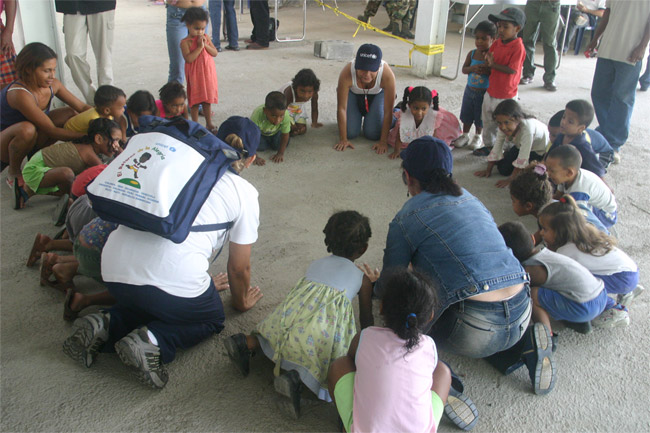Training and Capacity Building: Changing Mindsets
n this edition of our magazine you will find many examples of training courses and experiences relating to disaster risk reduction workshops and instruction. Training and capacity building are both important elements to improve and expand the risk management capacity of countries. While related, they have somewhat different meanings. Training is usually geared toward obtaining mastery or knowledge in a particular area and toward the acquisition of one or more specific skills. Capacity-building, however, is an in-depth process that goes beyond mastering specific skills, since one of its goals is to change attitudes by taking a more comprehensive approach to a particular issue.
Of course both approaches are equally important. It all depends on the goal and the most appropriate type of instruction based on the demand. The supply of courses has increased in recent years and options are available in many places and in many different forms. However, while an increased supply is something positive, this is not to say that all the options are equally valuable.
Perhaps one of the most innovative educational options in terms of content and philosophy of training is the Course on Disaster Risk Reduction in the Context of Local Sustainable Development, taught by the Local Development Network Program (DELNET), which is part of the International Training Center of the International Labor Organization (ITC/ILO). This edition contains a special supplement describing this new alternative.

Photo: UNICEF
If we are to see the short and long-term fruits of these courses, education and training clearly cannot be confined to the classroom. Special efforts are required to ensure that the expertise acquired through the courses is applied as often as possible. Vulnerability reduction requires working from many different angles, developing (new) policies and strategies in different areas. This must be done in the context of active cooperation between governments and civil society organizations, regional and multilateral institutions, and other actors. The key lies in (learning to) share the growing repertoire of knowledge available through the courses offered throughout the region.
There is reason to believe that the effects of global warming will intensify in the decades to come. It is difficult to forecast exactly what will happen and where, but we have many reasons to think that more extreme climate events will occur, and that climate and ecological conditions will require tremendous adaptation efforts (to climate change). Consider for instance drought patterns, changing ecosystems with successive variations in agricultural production cycles, and so forth. New training programs must take this into account with a view toward the future, anticipating the potential changes to which our societies will have to adjust.
When we refer to education and training, we often overlook risk reduction for vulnerable groups and fail to pay enough attention to those with special needs. This includes people with physical, cognitive, or sensory disabilities. We must be more aware of what we need to know in order to meet the needs of such groups. This is true not only in disaster situations; we must also ensure that legal frameworks emphasize access to information for those with special needs. In this sense, we are reiterating the importance of democratizing access to information for such groups and for those who work with and accompany them.
For those who think that we are referring to only a few people, it should be recalled that an estimated 10 to 15 percent of the total population has some sort of disability—in other words, we are referring to millions of people in the countries of the region. If we are seeking the genuine democratization of access to information, we must look at how to ensure the participation of all sectors of society. In Panama, our regional office is working with the Office of the First Lady of the Republic to examine how we can join forces to develop and apply work models that embody our desire to involve those with special needs in risk planning, management, and response.
The conditions in many areas of Latin America and the Caribbean are conducive to increased vulnerability. Poor regulatory frameworks and urban management, problems with environmental resource management, and social inequity are factors that keep broad swaths of society submersed in poverty and living in environmentally fragile and degraded areas. Unless these conditions improve significantly, we will likely experience cyclical disasters over the coming years. Education and training are clearly important tools for reducing vulnerability, working from various angles. The development of new training options must go hand in hand with improved access to technical and scientific information about disaster reduction. In this way, innovative work models can be developed to build a more widespread culture of prevention and new early warning systems, based on local possibilities and conditions.
It should be noted that there are a number of ways to ensure that human resources are trained in different learning environments: formal and semiformal education, while excellent and necessary options, are not the only opportunities for effective learning.
The Hyogo Framework for Action underscores the importance of education and training. The following approaches are among those included under Priority 3 (“Use knowledge, innovation, and education to build a culture of safety and resilience at all levels”): “Develop training and learning programs in disaster risk reduction targeted at specific sectors (development planners, emergency managers, local government officials, etc.),” as well as “Promote community-based training initiatives, considering the role of volunteers as appropriate, to enhance local capacities to mitigate and cope with disasters,” and “Ensure equal access to appropriate training and educational opportunities for women and vulnerable constituencies; promote gender and cultural sensitivity training as integral components of education and training for disaster risk reduction.”
We hope you enjoy reading this edition of your magazine.
|

